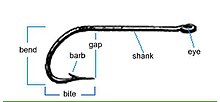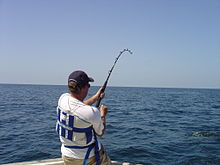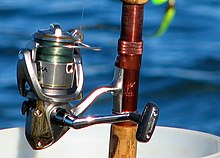Fishing tackle
Gear that is attached to the end of a fishing line is called terminal tackle. This includes hooks, leaders, swivels, sinkers, floats, split rings and wire, snaps, beads, spoons, blades, spinners and clevises to attach spinner blades to fishing lures.
Fishing tackle can be contrasted with fishing techniques. Fishing tackle refers to the physical equipment that is used when fishing, whereas fishing techniques refers to the manner in which the tackle is used when fishing.
The term tackle, with the meaning "apparatus for fishing", has been in use from 1398 AD.[1] Fishing tackle is also called fishing gear. However the term fishing gear is more usually used in the context of commercial fishing, whereas fishing tackle is more often used in the context of recreational fishing. For this reason, this article covers equipment used by recreational fishermen.
Hook, line and sinker
Hook, line and sinker is a classic combination of tackle empowering a fisherman to catch fish.Hooks
Main article: Fish hook
The use of the hook in angling is descended, historically, from what would today be called a "gorge". The word "gorge", in this context, comes from an archaic word meaning "throat". Gorges were used by ancient peoples to capture fish. A gorge was a long, thin piece of bone or stone attached by its midpoint to a thin line. The gorge would be fixed with a bait so that it would rest parallel to the lay of the line. When a fish swallowed the bait, a tug on the line caused the gorge to orient itself at right angles to the line, thereby sticking in the fish's gullet.A fish hook is a device for catching fish either by impaling them in the mouth or, more rarely, by snagging the body of the fish. Fish hooks have been employed for millennia by fishermen to catch fresh and saltwater fish. Early hooks were made from the upper bills of eagles and from bones, shells, horns and thorns of plants (Parker 2002). In 2005, the fish hook was chosen by Forbes as one of the top twenty tools in the history of man.[2] Fish hooks are normally attached to some form of line or lure device which connects the caught fish to the fisherman. There is an enormous variety of fish hooks. Sizes, designs, shapes, and materials are all variable depending on the intended purpose of the hook. They are manufactured for a range of purposes from general fishing to extremely limited and specialized applications. Fish hooks are designed to hold various types of artificial, processed, dead or live baits (bait fishing); to act as the foundation for artificial representations of fish prey (fly fishing); or to be attached to or integrated into other devices that represent fish prey (lure fishing).
Lines
Main article: Fishing line
A fishing line is a cord used or made for fishing. The earliest fishing lines were made from leaves or plant stalk (Parker 2002). Later lines were constructed from horse hair or silk thread, with catgut leaders. From the 1850s, modern industrial machinery was employed to fashion fishing lines in quantity. Most of these lines were made from linen or silk, and more rarely cotton.[3]Modern lines are made from artificial substances, including nylon, polyethylene, dacron and dyneema. The most common type is monofilament made of a single strand. Fishermen often use monofilament because of its buoyant characteristics and its ability to stretch under load. Recently, other alternatives to standard nylon monofilament lines have been introduced made of copolymers or fluorocarbon, or a combination of the two materials. There are also braided fishing lines, cofilament and thermally fused lines, also known as 'superlines' for their small diameter, lack of stretch, and great strength relative to standard nylon monofilament lines.
Important parameters of a fishing line are its length, material, and weight (thicker, sturdier lines are more visible to fish). Factors that may determine what line an angler chooses for a given fishing environment include breaking strength, knot strength, UV resistance, castability, limpness, stretch, abrasion resistance, and visibility.
Fishing with a hook and line is called angling. In addition to the use of the hook and line used to catch a fish, a heavy fish may be landed by using a landing net or a hooked pole called a gaff. Trolling is a technique in which a fishing lure on a line is drawn through the water. Snagging is a technique where the object is to hook the fish in the body.
Sinkers
Main article: Fishing sinker
A sinker or plummet is a weight used when angling to force the lure or bait to sink more rapidly or to increase the distance that it may be cast. The ordinary plain sinker is traditionally made of lead. It can be practically any shape, and is often shaped round like a pipe-stem, with a swelling in the middle. However, the use of smaller lead based fishing sinkers has now been banned in the UK, Canada and some states in the USA,[4] since lead can cause toxic lead poisoning if ingested. There are loops of brass wire on either end of the sinker to attach the line. Weights can range from a quarter of an ounce for trout fishing up to a couple of pounds or more for sea bass and menhaden.The swivel sinker is similar to the plain one, except that instead of loops, there are swivels on each end to attach the line. This is a decided improvement, as it prevents the line from twisting and tangling. In trolling, swivel sinkers are indispensable. The slide sinker, for bottom fishing, is a leaden tube which allows the line to slip through it, when the fish bites. This is an excellent arrangement, as the fisherman can feel the smallest bite, whereas in the other case the fish must first move the sinker before the fisherman feels him.
Fishing rods
Main article: Fishing rod
A fishing rod is an additional tool used with the hook, line and sinker. A length of fishing line is attached to a long, flexible rod or pole: one end terminates with the hook for catching the fish. Early fishing rods are depicted on inscriptions in ancient Egypt, China, Greece and Rome. In Medieval England they were called angles (hence the term angling). As they evolved they were made from materials such as split Tonkin bamboo, Calcutta reed, or ash wood, which were light, tough, and pliable. The butts were frequently made of maple. Handles and grips were made of cork, wood, or wrapped cane. Guides were simple wire loops.Modern rods are sophisticated casting tools fitted with line guides and a reel for line stowage. They are most commonly made of fibreglass, carbon fibre or, classically, bamboo. Fishing rods vary in action as well as length, and can be found in sizes between 24 inches and 20 feet. The longer the rod, the greater the mechanical advantage in casting. There are many different types of rods, such as fly rods, spin and bait casting rods, spinning rods, ice rods, surf rods, sea rods and trolling rods.
Fishing rods can be contrasted with fishing poles. A fishing pole is a simple pole or stick with a line which is fastened to the tip and suspended with a hooked lure or bait at the other end.
Fishing reels
Main article: Fishing reel
A fishing reel is a device used for the deployment and retrieval of a fishing line using a spool mounted on an axle. Fishing reels are traditionally used in angling. They are most often used in conjunction with a fishing rod, though some specialized reels are mounted on crossbows or to boat gunwales or transoms. The earliest known illustration of a fishing reel is from Chinese paintings and records beginning about 1195 A.D. Fishing reels first appeared in England around 1650 A.D., and by the 1760s, London tackle shops were advertising multiplying or gear-retrieved reels. Paris, Kentucky native George Snyder is generally given credit for inventing the first fishing reel in America around 1820, a bait casting design that quickly became popular with American anglers.Fishing bait
Main article: Fishing bait
- Natural baits
- Artificial baits
Bite indicators
Main article: Bite indicator
A bite indicator is a mechanical or electronic device which indicates to an angler that something is happening at the hook end of the fishing line. There are many types of bite indicators. Which ones work best depends on the type of fishing.Other devices which are widely used as bite indicators are floats which float in the water, and dart about if a fish bites, and quiver tips which are mounted onto the tip of the fishing rod. Bite alarms are electronic devices which bleep when a fish tugs a fishing line. Whereas floats and quiver tips are used as visual bite detectors, bite alarms are audible bite detectors.
Spears
Main article: Spearfishing
Nets
Main article: Fishing nets
Traps
Main article: Fishing trap
Fly fishing tackle
Main article: Fly fishing tackle
Fly fishing tackle is equipment used by, and often specialised for use by fly anglers. Fly fishing tackle includes fly lines designed for easy casting, specialised fly reels designed to hold a fly line and supply drag if required for landing heavy or fast fish, specialised fly rods designed to cast fly lines and artificial flies, terminal tackle including artificial flies, and other accessories including fly boxes used to store and carry artificial flies.- Article Source: http://en.wikipedia.org/
More Stories: http://blackboxfishtalk.blogspot.com/













No comments:
Post a Comment